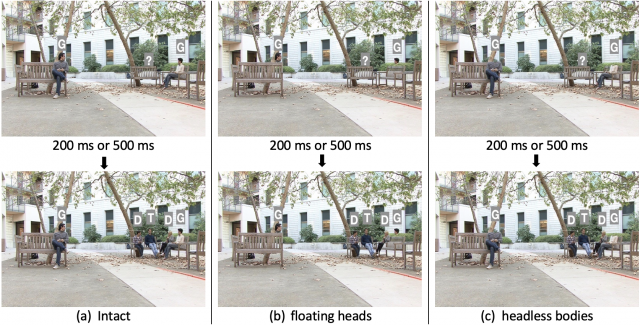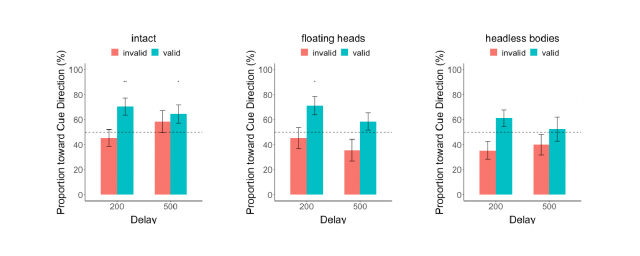New paper from VIU grad student Nicole Han shows gaze-cued attention shifts are sustained for whole bodies, transient for body parts
The findings provide crucial new knowledge about how the brain selects information from the complexity of real-world environments

Gaze direction is an evolutionarily important mechanism in daily social interactions. It reflects a person’s internal cognitive state, spatial locus of interest, and predicts future actions (Emery, 2000). Studies have used static head images presented foveally and simple synthetic tasks to find that gaze orients attention and facilitates target detection at the cued location in a sustained manner (Friesen et al., 2004, Ristic et al., 2007). Yet, little is known about how people’s natural gaze behavior, including eyes, head, and body movements, jointly orient covert attention, microsaccades, and facilitate performance in more ecological dynamic scenes. To address this crucial gap in knowledge, VIU graduate student Nicole Han, in collaboration with VIU PI Miguel Eckstein, present measurements of spatial shifts of attention induced by others' gaze directions in naturalistic real-world videos in their new paper, "Gaze-cued shifts of attention and microsaccades are sustained for whole bodies but are transient for body parts" published in the current issue of Psychonomic Bulletin & Review.

In the study, participants completed a target person detection task with videos of real scenes. The videos showed people looking toward (valid cue) or away from a target (invalid cue) location. We digitally manipulated the individuals in the videos directing gaze to create three conditions: whole-intact (head and body movements), floating heads (only head movements), and headless bodies (only body movements). We assessed their impact on participants’ behavioral performance and microsaccades during the task. We found that, in isolation, an individual’s head or body orienting toward the target-person direction led to facilitation in detection that is transient in time (200 ms). In contrast, only the whole-intact condition led to sustained facilitation (500 ms). Furthermore, observers executed microsaccades more frequently towards the cued direction for valid trials, but this bias was sustained in time only with the joint presence of head and body parts. Together, the results differ from previous findings with foveally presented static heads. In more real-world scenarios and tasks, sustained attention requires the presence of the whole-intact body of the individuals dynamically directing their gaze.
References
Emery, N. J. (2000). The eyes have it: The neuroethology, function and evolution of social gaze. Neuroscience & Biobehavioral Reviews, 24(6), 581–604.
Friesen, C. K., Ristic, J., & Kingstone, A. (2004). Attentional effects of counterpredictive gaze and arrow cues. Journal of Experimental Psychology: Human Perception and Performance, 30(2), 319– 329. https://doi.org/10.1037/0096-1523.30.2.319
Ristic, J., Wright, A., & Kingstone, A. (2007). Attentional control and reflexive orienting to gaze and arrow cues. Psychonomic Bulletin & Review, 14(5), 964–969. https://doi.org/10.3758/BF03194129